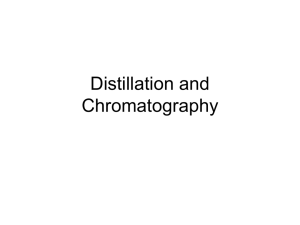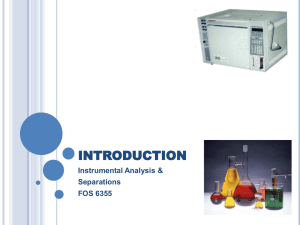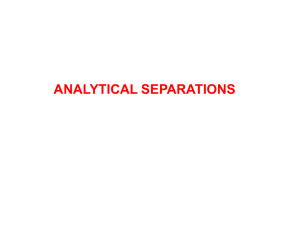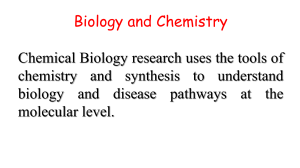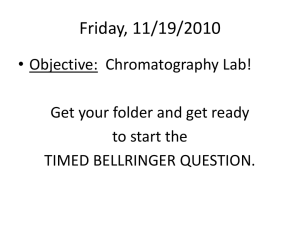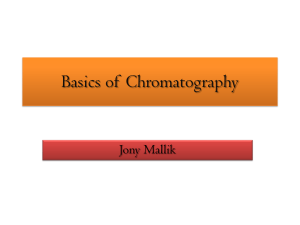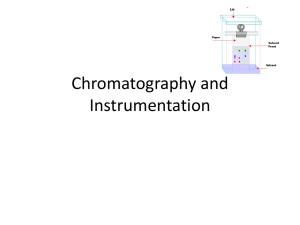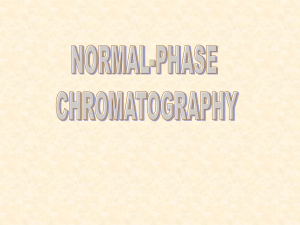Chromatography (2)
advertisement
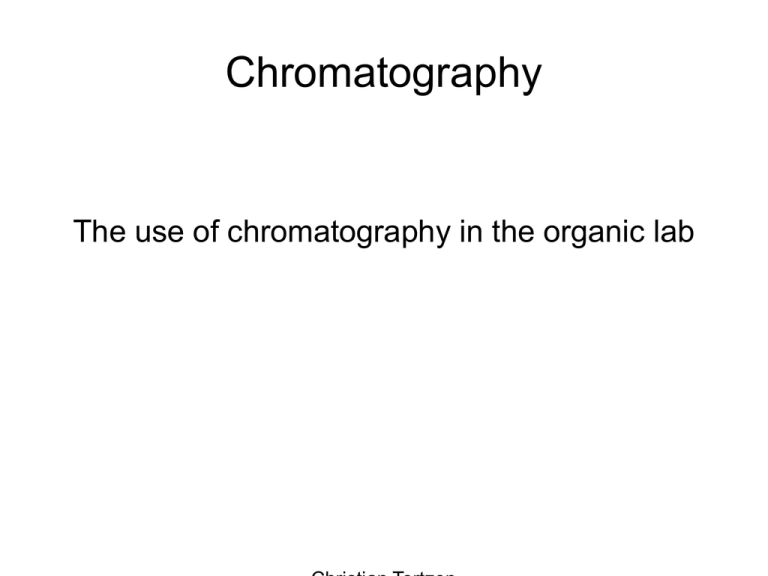
Chromatography The use of chromatography in the organic lab Agenda ● Introduction ● Very little theory ● Stationary phase ● Mobile phase ● Analytical methods ● Preparative methods ● Gravitational/Flash chromatography ● Dry Column Vacuum Chromatography Theory ● Distribution coefficient ● Theoretical plates ● HETP ● Band broadening Theory The stationary phase ● Silica ● Aluminiumxoid ● Basic ● Acidic ● Activity ● E vs T ● Reversed-phase silica ● Cellulose, florisil, BioBeads, Sephadex The stationary phase ● Silica Particle size ● 63-200 μm - Gravitation/MPLC ● 40-63 μm - Flash/MPLC ● 15-40 μm - DCVC ● 5-15 μm – TLC/HPLC The mobile phase ● Not as restricted as the stationary phase ● Solvent parameters ● Polarity ● Selectivity ● Solvent groups ● Binary eluent mixtures The mobile phase Analytical methods ● ● Automated techniques ● Analytical HPLC ● LC-MS ● LC-NMR TLC TLC ● Aluminiumoxide - F254 ● Reversed phase silica – No indicator! ● Silica - F254 ● 2D-TLC ● TLC-MS ● TLC-NMR TLC ● Development / visualisation ● UV ● 2,4-DNPH ● Ninhydrin ● CAN ● Many more! Preparative methods ● Preparative TLC ● Easy transfer of results from analytical TLC ● Easy visualisation ● No need for further TLC-analysis ● Small amounts per plate Column Chromatography ● HPLC ● Small particle size / High Pressure ● Very expensive columns ● Typically reverse phase ● Elaborate setup, DAD, fraction collector ● Great resolution ● Typically several runs needed for prep. scale ● Pre-columns and extensive wash needed Column Chromatography ● Gravitational/classic column chromatography ● ● Slurry packed with a solvent reservoir Typically done with 40-63μm or 63-200μm particle size ● Good resolution possible on “known columns” ● Time consuming ● Often done “blindly” ● Can be done faster with pressure ● Huge amounts of solvent needed ● Eluent system and column length often guestimated Column Chromatography ● Flash Column Chromatography ● Very narrow definition ● 45-63μm particle size ● Defined flow rate: 5 cm / min ● Eluent mixture determined by TLC – Rf = 0.35 ● Crude method - resolution only trivial ΔRf ≥ 0.15 ● Optimum packed length = 18 cm ● 1L solvent per gram loaded compound needed ● Amounts above 10 g are non trivial Column Chromatography ● Dry Column Vacuum Chromatography Column Chromatography ● Dry Column Vacuum Chromatography ● Equipment ● Silica – 15-40μm ● Solvents ● Length of packed column ● Loading amounts - 500 mg/cm² - π*r² ● Fraction Volume – Follows the column ● Packing Column Chromatography ● Dry Column Vacuum Chromatography ● Scalability ● Economy ● ● ● Time saved in post column analysis and evaporation Separations impossible using Flash routinely achievable Shaping of gradient makes separation below TLC resolution possible Column Chromatography ● Dry Column Vacuum Chromatography ● Sample loading ● Gradient elution ● Choice of eluent system and gradient ● Example 25% EtOAc/Heptane give Rf = 0.3 with large ΔRf – 5 Steps until this polarity give a 5% gradient (25/5) – Other types of chromatography ● Size exclusion chromatography ● Chromatotron ● 3D chromatotron ● Counter current ● Single run dry column ● Quartz columns Modified silica ● Reverse phase ● Aromatics ● Doping ● Affinity Chromatography ● Chiral chromatography ● Self prepared modified silica
